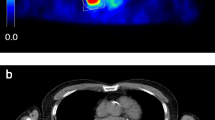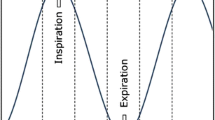Abstract
Purpose
To assess the additional functional vascular information and the relationship between perfusion measurements and glucose metabolism (SUVmax) obtained by including a perfusion CT study in a whole-body contrast-enhanced PET/CT protocol in primary lung cancer lesions.
Methods
Enrolled in this prospective study were 34 consecutive patients with a biopsy-proven diagnosis of lung cancer who were referred for contrast-enhanced PET/CT staging. This prospective study was approved by our institutional review board, and informed consent was obtained from all patients. Perfusion CT was performed with the following parameters: 80 kV, 200 mAs, 30 scans during intravenous injection of 50 ml contrast agent, flow rate 5 ml/s. Another bolus of contrast medium (3.5 ml/s, 80 ml, 60-s delay) was administered to ensure a full diagnostic contrast-enhanced CT scan for clinical staging. The perfusion CT data were used to calculate a range of tumour vascularity parameters (blood flow, blood volume and mean transit time), and tumour FDG uptake (SUVmax) was used as a metabolic indicator. Quantitative and functional parameters were compared and in relation to location, histology and tumour size. The nonparametric Kruskal-Wallis rank sum test was used for statistical analysis.
Results
A cut-off value of 3 cm was used according to the TNM classification to discriminate between T1 and T2 tumours (i.e. T1b vs. T2a). There were significant perfusion differences (lower blood volumes and higher mean transit time) between tumours with diameter >30 mm and tumours with diameter <30 mm (p < 0.05; blood volume 5.6 vs. 7.1 ml/100 g, mean transit time 8.6 vs. 3.9 s, respectively). Also there was a trend for blood flow to be lower in larger lesions (p < 0.053; blood flow 153.1 vs. 98.3 ml/100 g tissue/min). Significant inverse correlations (linear regression) were found between blood volume and SUVmax in tumours with diameter >30 mm in diameter.
Conclusion
Perfusion CT combined with PET/CT is feasible technique that may provide additional functional information about vascularity and tumour aggressiveness as a result of lower perfusion and higher metabolism shown by larger lesions.




Similar content being viewed by others
References
WHO. Cancer. World Health Organization.
Travis WD, Travis LB, Devesa SS. Lung cancer. Cancer. 1995;75 1 Suppl:191–202.
Antoch G, Stattaus J, Nemat AT, Marnitz S, Beyer T, Kuehl H, et al. Non-small cell lung cancer: dual-modality PET/CT in preoperative staging. Radiology. 2003;229(2):526–33.
Nabi HA, Zubeldia JM. Clinical applications of (18)F-FDG in oncology. J Nucl Med Technol. 2002;30:3–9.
Kambadakone AR, Sahani DV. Body perfusion CT: technique, clinical applications, and advances. Radiol Clin North Am. 2009;47(1):161–78.
Duffy JP, Eibl G, Reber HA, Hines OJ. Influence of hypoxia and neoangiogenesis on the growth of pancreatic cancer. Mol Cancer. 2003;2:12. doi:10.1186/1476-4598-2-12.
Bisdas S, Spicer K, Rumboldt Z. Whole-tumor perfusion CT parameters and glucose metabolism measurements in head and neck squamous cell carcinomas: a pilot study using combined positron-emission tomography/CT imaging. AJNR Am J Neuroradiol. 2008;29:1376–81.
Miles KA. Tumor angiogenesis and its relation to contrast enhancement on computed tomography: a review. Eur J Radiol. 1999;30:198–205.
Sahani DV, Kalva SP, Hamberg LM, Hahn PF, Willett CG, Saini S, et al. Assessing tumor perfusion and treatment response in rectal cancer with multisection CT: initial observations. Radiology. 2005;234:785–92.
Ma SH, Le HB, Jia BH, Wang ZX, Xiao ZW, Cheng XL, et al. Peripheral pulmonary nodules: relationship between multi-slice spiral CT perfusion imaging and tumor angiogenesis and VEGF expression. BMC Cancer. 2008;8:186–202.
Wang J, Wu N, Cham MD, Song Y. Tumor response in patients with advanced non-small cell lung cancer: perfusion CT evaluation of chemotherapy and radiation therapy. AJR Am J Roentgenol. 2009;193(4):1090–6.
Li Y, Yang ZG, Chen TW, Chen HJ, Sun JY, Lu YR. Peripheral lung carcinoma: correlation of angiogenesis and first-pass perfusion parameters of 64-detector row CT. Lung Cancer. 2008;61(1):44–53.
Miles KA, Griffiths MR, Keith CJ. Blood flow-metabolic relationships are dependent on tumor size in non-small cell lung cancer: a study using quantitative contrast-enhanced computer tomography and positron emission tomography. Eur J Nucl Med. 2006;33(1):22–8.
Yildiz E, Ayan S, Goze F, Gokce G, Gultekin EY. Relation of microvessel density with microvascular invasion, metastasis and prognosis in renal cell carcinoma. BJU Int. 2008;101(6):758–64.
Kiessling F, Boese J, Corvinus C, Ederle J, Zuna I, Schoenberg S, et al. Perfusion CT in patients with advanced bronchial carcinomas: a novel chance for characterization and treatment monitoring? Eur Radiol. 2004;14(7):1226–33.
Kohler HH, Barth PJ, Siebel A, Gerharz EW, Bittinger A. Quantitative assessment of vascular surface density in renal cell carcinomas. Br J Urol. 1996;77:650–4.
Delahunt B, Bethwaite PB, Thornton A. Prognostic significance of microscopic vascularity for clear cell renal carcinoma. Br J Urol. 1997;80:401–4.
Rioux-Leclercq N, Epstein JI, Bansard JY, Turlin B, Patard JJ, Manunta A, et al. Clinical significance of cell proliferation, microvessel density, and CD44 adhesion molecule expression in renal cell carcinoma. Hum Pathol. 2001;32:1209–15.
Rajendran JG, Mankoff DA, O'Sullivan F, Peterson LM, Schwartz DL, Conrad EU, et al. Hypoxia and glucose metabolism in malignant tumors: evaluation by [18F]fluoromisonidazole and [18F]fluorodeoxyglucose positron emission tomography imaging. Clin Cancer Res. 2004;10(7):2245–52.
Rajendran JG, Schwartz DL, O’Sullivan J, Peterson LM, Ng P, Scharnhorst J, et al. Tumor hypoxia imaging with [F-18] fluoromisonidazole positron emission tomography in head and neck cancer. Clin Cancer Res. 2006;12:5435–41.
Miles KA, Griffiths MR, Fuentes MA. Standardized perfusion value: universal CT contrast enhancement scale that correlates with FDG PET in lung nodules. Radiology. 2001;220(2):548–53.
Cappabianca S, Porto A, Petrillo M, Greco B, Reginelli A, Ronza F, et al. Preliminary study on the correlation between grading and histology of solitary pulmonary nodules and contrast enhancement and [18F]fluorodeoxyglucose standardised uptake value after evaluation by dynamic multiphase CT and PET/CT. J Clin Pathol. 2011;64:114–9.
Ng QS, Goh V, Fichte H, Klotz E, Fernie P, Saunders MI, et al. Lung cancer perfusion at multi-detector row CT: reproducibility of whole tumor quantitative measurements. Radiology. 2006;239(2):547–53.
Ng QS, Goh V, Klotz E, Fichte H, Saunders MI, Hoskin PJ, et al. Quantitative assessment of lung cancer perfusion using MDCT: does measurement reproducibility improve with greater tumor volume coverage? AJR Am J Roentgenol. 2006;187(4):1079–84.
Veit-Haibach P, Treyer V, Strobel K, Soyka JD, Husmann L, Schaefer NG, et al. Feasibility of integrated CT-liver perfusion in routine FDG-PET/CT. Abdom Imaging. 2010;35(5):528–36.
Goh V, Halligan S, Gharpuray A, Wellsted D, Sundin J, Bartram CI. Quantitative assessment of colorectal cancer tumor vascular parameters by using perfusion CT: influence of tumor region of interest. Radiology. 2008;247(3):726–32.
Chung HH, Kim JW, Han KH, Eo JS, Kang KW, Park NH, et al. Prognostic value of metabolic tumor volume measured by FDG-PET/CT in patients with cervical cancer. Gynecol Oncol. 2011;120(2):270–4.
Hyun SH, Choi JY, Shim YM, Kim K, Lee SJ, Cho YS, et al. Prognostic value of metabolic tumor volume measured by 18F-fluorodeoxyglucose positron emission tomography in patients with esophageal carcinoma. Ann Surg Oncol. 2010;17:115–22.
Lee P, Weerasuriya DK, Lavori PW, Quon A, Hara W, Maxim PG, et al. Metabolic tumor burden predicts for disease progression and death in lung cancer. Int J Radiat Oncol Biol Phys. 2007;69(2):328–33.
Conflicts of interest
None.
Author information
Authors and Affiliations
Corresponding author
Rights and permissions
About this article
Cite this article
Ippolito, D., Capraro, C., Guerra, L. et al. Feasibility of perfusion CT technique integrated into conventional 18FDG/PET-CT studies in lung cancer patients: clinical staging and functional information in a single study. Eur J Nucl Med Mol Imaging 40, 156–165 (2013). https://doi.org/10.1007/s00259-012-2273-y
Received:
Accepted:
Published:
Issue Date:
DOI: https://doi.org/10.1007/s00259-012-2273-y




